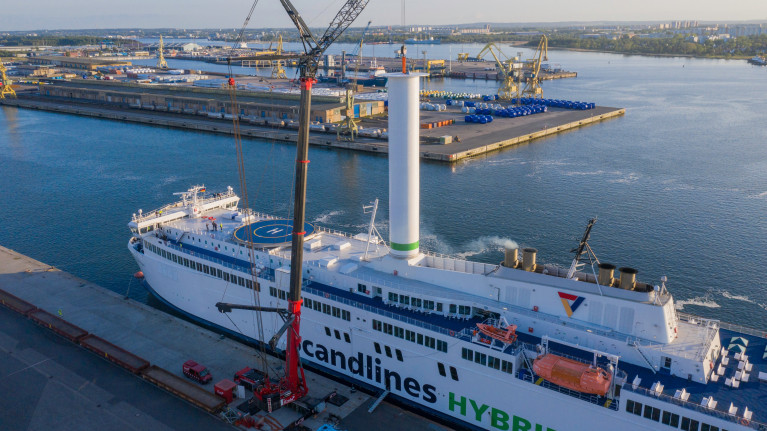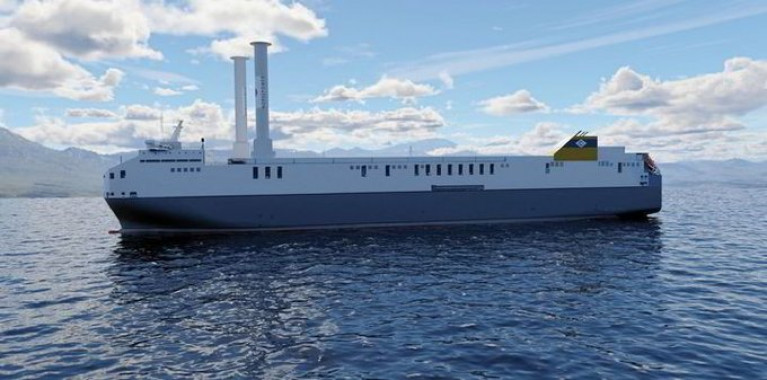Displaying items by tag: Rotor Sails
In the German port of Rostock, Norsepower has completed the second installation onboard a Scanlines ferry, the M/V Berlin which was carried out in just a few hours.
The installation follows a successful use of a Norsepower Rotor Sail on the sister hybrid ferry M/V Copenhagen in 2020, and a year of demonstrated results.
Since 2013, Scandlines has invested more than EUR 300 million in building and converting conventional ferries into hybrid ferries. In 2020, the ferry operator decided to adopt wind propulsion technology by installing Norsepower’s Rotor Sail on the hybrid ferry M/V Copenhagen, which operates on the Rostock-Gedser route between Germany and Denmark, a route which offers very favourable conditions for using Rotor Sails.
After just a year in operation, the Rotor Sail onboard the MV Copenhagen delivered reductions in fuel consumption, and CO2 emissions by 4% on average. Under optimal conditions, emissions reductions can be further increased to 20%. Given these positive results, Scandlines proceeded with the installation of Norsepower Rotor Sails on M/V Berlin in the port of Rostock on 16 May 2022.
Michael Guldmann Petersen, COO, Scandlines said: “After positive experiences with the Rotor Sail on the Scandlines hybrid ferry Copenhagen, Scandlines had prepared the sister ferry Berlin for a Rotor Sail as well. We are happy to see, that the installation was successfully completed and that the ferry went into operation again this morning as planned.”
Tuomas Riski, CEO, Norsepower commented on the latest installation: “Scandlines is taking the international GHG emissions reductions targets extremely seriously and is demonstrating a leading approach to investing in innovation to supersede these. Expanding its use of our Rotor Sail technology on its second vessel highlights the viability of wind power, and the significance of the emissions savings which can be achieved.”
Norsepower’s Rotor Sail solution is fully automated: the system measures the wind speed and direction, based on which it calculates whether using the Rotor Sail will reduce emissions or not. If the conditions are favourable, the Rotor Sail starts automatically. However, for specific port areas which are not suitable for Rotor Sails, the solution has settings to ensure the technology will not be activated.
The company is also currently preparing two Rotor Sails for CLdN with the installation on board a 2018-built Ro-Ro vessel (MV Delphine which Afloat reported). This project is anticipated to be completed by December 2022.
CLdN Announce Intallation of 'Rotor Sails' On the World's Largest Short Sea Ro-Ro Freight Vessel
CLdN, the logistics specialist for road, sea and rail is to install two tilting Rotor Sails on board a 2018-built ro-ro vessel, the MV Delphine which is the largest short sea RoRo vessel operating in the world.
The MV Delphine, a vessel with a cargo capacity of close to 8,000 lane meters, transits between the UK, Ireland and Europe (see story). A sister Celine, was dubbed the 'Brexit-Buster' following introduction in the same year on Dublin-mainland Europe routes to Belgium and The Netherlands.
With two 35mx5m Rotor Sails, Norsepower Oy Ltd in Finland, has estimated that the technology would achieve a fuel and emission reduction saving of between 7 to 10% for the MV Delphine, depending on the route.
The Norsepower Rotor Sail Solution - which can be installed on new vessels or retrofitted on existing ships - is a modernised version of the Flettner rotor, a spinning cylinder that uses the Magnus effect to harness wind power to thrust a ship. At the time of contract signing, this will be the seventh vessel to be installed with Norsepower’s Rotor Sails.
Tuomas Riski, CEO, Norsepower, commented on the agreement: “Seeing the interest grow in our tilting Rotor Sail design demonstrates how the industry is looking for proven, flexible solutions to lower carbon emissions and reduce fuel costs across a range of vessel sizes and operations.
“Norsepower’s Rotor Sail installation on the MV Delphine demonstrates how the use of clean technology can modernise and evolve the performance of fleets’ younger vessels to manage emissions and help to increase asset value. With fuel becoming increasingly expensive, making savings will also have a huge impact on commercial success. Working with CLdN and its ambitious team is an opportunity to demonstrate what our technology has to offer to continue strengthening the environmental and commercial performance of its fleet.”
Gary Walker, COO Shipping, CLdN, added: “In 2021, CLdN announced it is the top performer amongst its ro-ro shipping peers in Northwest Europe for CO2 emissions per tonne of freight carried. By investing in technologically advanced ships and terminals, CLdN enables its customers to improve their carbon footprint and support them at the same time in making their supply chains more efficient and robust. This demand for cleaner shipping is growing and we are committed to making measurable progress. Installing two of Norsepower’s Rotor Sails will maximise our fuel and emissions savings on the MV Delphine, and this pilot project will help determine how the Rotor Sail technology could be rolled out on the current CLdN fleet and our new-build vessels. We look forward to the installation and subsequent results.”
The Norsepower Rotor Sail is the first third-party verified and commercially operational auxiliary wind propulsion technology for the global maritime industry. The solution is fully automated and detects whenever the wind is strong enough to deliver fuel and emission savings, at which point the Rotor Sails start automatically. This is the third installation of the tilting Rotor Sail function, highlighting the growing interest in the flexibility of the latest design.






























































